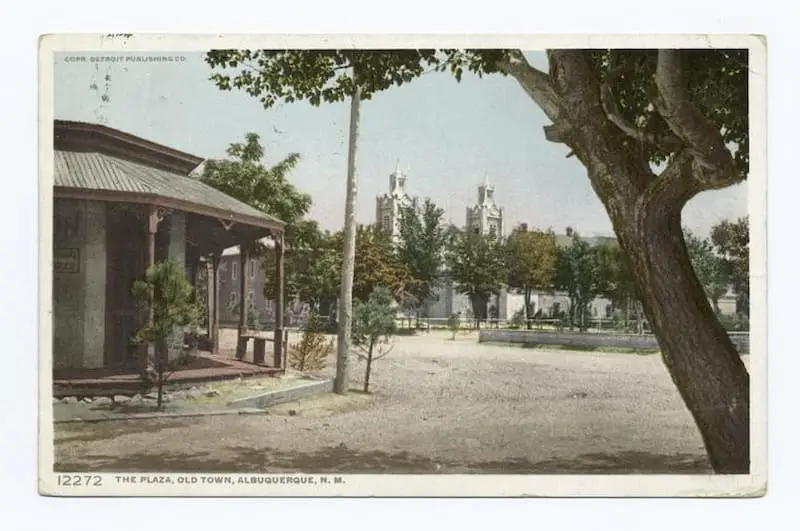Glimpse history through old images of Las Vegas, New Mexico, in the USA.

Historic Timeline
Las Vegas Historical Timeline [Virtual New Mexico Project] – VNMP Las Vegas on YouTube
A Bit of Las Vegas NM History
Extract from:
A Complete Business Directory of New Mexico, and Gazetteer of the Territory for 1882
Pages 111 – 116
Las Vegas, the county seat and most important town in San Miguel county, is situated in the beautiful valley of the Gallinas, on high and rolling ground, with a broad expanse of plain broken by mesas to the east and mountain ranges in the western distance.
In the neighboring mountains are almost limitless supplies of pine timber, and several saw mills are busily engaged in making lumber to supply the local demand, and the towns in other parts of the Territory.
Coal has been discovered near at hand, and the mines will soon be in process of development.
There are also inexhaustible supplies of building stone in the hills, of the finest quality.
The finest quality of fire clay is also said to exist here, and a company has
been organized to bring it into use.
Although containing a population of nearly 6,000, the town has never been
organized as a city, and has no city government. The police are maintained by
private subscription.
The climate of Las Vegas is one of its greatest attractions. In the latitude of
Memphis, Tenn., and at an elevation of 6,400 feet, the winters are not severely
cold, but little snow falls, and that remains only a few days; and the warm summers are tempered by refreshing winds and cool nights.
Las Vegas is the shipping and trading point for a very large section of country. The merchants of Las Vegas have abundant capital and unlimited pluck and enterprise. They carry large stocks and they are working industriously for trade all over the Territory.
The dimension of the buildings, the large stocks of merchandise, the amount of
capital employed, and the large number of rich merchants to be found in Las
Vegas, are sufficient to astonish the stranger who may take the pains to investigate a little.
The Agua Pura company, of which Mr. I. P. Browne is president, was organized in December, 1881. The works have just been completed and put in operation at a cost of one hundred thousand dollars.
The water is brought a distance of six miles, from a reservoir formed by damming the Gallinas, and comes to the consumer as clear and pure as the snows from which it was distilled. The pressure in the town is 12 pounds to the inch, showing a fall of over 300 feet.
Fire plugs have been provided, and the city is now amply protected against fire.
The water mains are being extended to every portion of the city.
The gas works were put in operation in July, 1881, and since that time Las Vegas has had a supply of good gas. The company, called the Las Vegas Gas and Coke company, is formed entirely of citizens of Las Vegas.
The works have cost about sixty thousand dollars, and their capacity is now forty thousand cubic feet. Gas is supplied at three dollars per thousand. The company keeps all kinds of gas fixtures, and of the latest and most elegant designs.
Another mark of the progressive public spirit of Las Vegas is its street rail road, connecting the old and new quarters. It is a first-class road and is equipped in the best of style, making trips every five minutes. It is doing a big business and making a reasonably large profit on the investment.
A telephone exchange has been established and in operation for several months. Nearly all the business houses have been connected, and business between the two quarters of the town is thus greatly facilitated. A wire also connects the Hot Springs hotel with the central office and with the town subscribers.
The banking business of Las Vegas is transacted by two national banks, the First National and the San Miguel National.
The educational facilities possessed by Las Vegas are unsurpassed in the Territory, except, of course, by those of Santa Fe.
The Jesuit Fathers have charge of a flourishing college for young men, which is very extensively patronized by the citizens of this and the adjoining States and Territories.
The management have now under consideration plans for a new college building, estimated to cost $25,000. It will be erected at once.
Besides this, there are several public and private schools, all well attended.
The press of Las Vegas has done much to advance its interests and increase the trade controlled by it. There are two dailies – the “Gazette” and the “Optic’ – the former publishing the associated press telegrams. Both of these offices issue weekly editions.
The “Revista Catolica,” a Spanish weekly, is published by the Jesuit Fathers, and has a very large circulation among the native population all over the Territory.
The monthly publications issued in Las Vegas comprise the “Mining World,” “Great Southwest,” “Guide to New Mexico,” and the “Real Estate and Mining Index.” The three last named are devoted almost exclusively to the real estate interests of the city and county.
This brief review of one of the principal towns of the Territory does not, of course, contain many points of interest which could be given in a more extended write-up, but it can be seen from the above that Las Vegas will always retain its present position among the cities of New Mexico.





